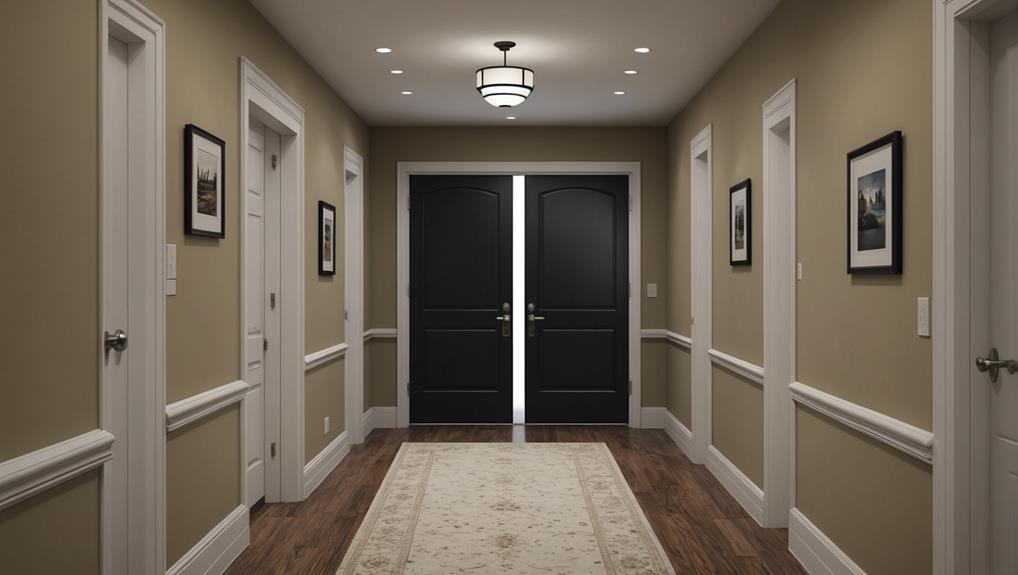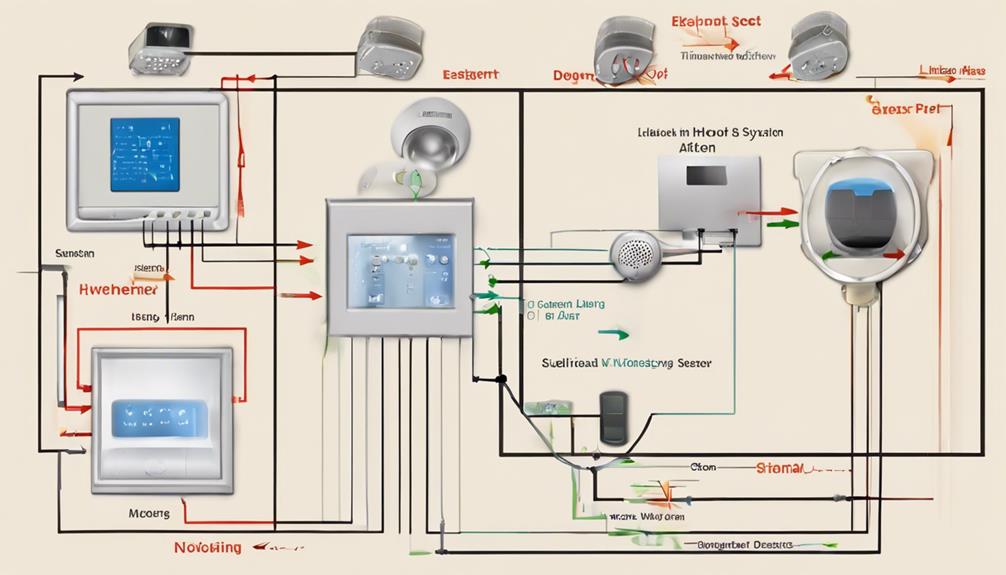Motion sensors in home alarm systems work by detecting movement using technologies like Passive Infrared (PIR) and Microwave Sensors that sense heat and emit pulses to cover different ranges. Ultrasonic Sensors rely on sound waves for inside security, while Dual Technology Sensors combine PIR and microwave to lessen false alarms common in residential areas. Sensors should be strategically placed in hallways, near valuables, and with clear visibility for peak performance. Regular maintenance, like adjusting sensitivity and cleaning lenses, guarantees accuracy. If you want to enhance safety and convenience, consider integrating motion sensors for automatic lighting, smart home features, or even pet monitoring.
Key Takeaways
- Motion sensors detect infrared heat or movement to trigger alarms.
- They use technologies like PIR, microwave, or ultrasonic sensors.
- Dual technology combines PIR and microwave for enhanced accuracy.
- Sensors are strategically placed in key areas for optimal coverage.
- Regular calibration and maintenance ensure reliable performance.
Motion Sensor Technologies

Motion sensors in home alarm systems operate using various technologies to detect movement within a designated area. The primary motion detection technology includes Passive Infrared (PIR), which senses body heat, microwave sensors emitting pulses to detect movement, and ultrasonic sensors using sound waves for motion identification.
PIR sensors are the most common, measuring changes in infrared radiation caused by moving objects within a range of 20 to 50 feet. Microwave sensors cover larger areas, are less affected by barriers, but tend to be pricier than PIR sensors.
Dual technology sensors combine PIR and microwave for improved accuracy and reduced false alarms, making them popular for residential security. Features like pet immunity and sensitivity adjustments cater to specific needs, ensuring reliable detection without unnecessary alerts.
Understanding these motion sensor technologies helps optimize security solutions for your home, providing peace of mind and protection for you and your loved ones.
Types of Motion Sensors

Building on the understanding of motion sensor technologies discussed earlier, it is valuable to explore the different types of motion sensors commonly utilized in home alarm systems. Below is a breakdown of the types of motion sensors along with their key features:
| Motion Sensor Type | Key Features |
|---|---|
| Passive Infrared (PIR) Sensors | Detects movement by sensing changes in infrared radiation; range: 20 to 50 feet. |
| Microwave Sensors | Covers larger areas; effective at detecting motion through obstacles; range often exceeds 80 feet. |
| Ultrasonic Sensors | Emits high-frequency sound waves; suitable for indoor applications around entry points; detects movement. |
| Dual Technology Sensors | Reduces false alarms by combining PIR and microwave technology; increases reliability in various environments. |
Understanding the distinctions between these types of motion sensors can help you make informed decisions when setting up your home alarm system. Each type offers unique advantages and is suited for specific security needs.
Sensor Placement Tips

When setting up your home alarm system, the strategic placement of sensors plays a critical role in its effectiveness.
To make the most of your home alarm motion detectors, consider the following placement tips:
- Position sensors at choke points like hallways and stairwells to maximize coverage against intruders.
- Install infrared sensors 10-15 feet away from heat sources to prevent false alarms from temperature changes.
- Place sensors in rooms with valuable items and at entry points like doors and windows to boost security.
It's also important to be mindful of common issues that can arise during installation, such as interference from other wireless devices.
Ascertain sensors have a clear line of sight by avoiding obstructions that could block their view.
For peak security coverage, especially in larger homes, it's advisable to consult professional installers for expert placement strategies.
Motion Sensor Installation Guide

To guarantee the ideal functionality of your home alarm system, proper installation of the motion sensors is essential.
When installing motion sensors in alarms, remember to place them at least 10-15 feet away from heat sources to prevent false alarms. According to best practices, it's important to take into account the area you want to monitor when determining the number of sensors needed, as their detection range typically varies from 20 to 100 feet.
For best coverage, mount the sensors in corners or high walls to increase their range and minimize interference. If you opt for wired sensors, it's best to seek professional installation to secure correct wiring and integration with existing security systems.
However, wireless sensors offer easier installation for DIY users.
Sensor Calibration and Maintenance

To guarantee peak performance of your home alarm system, regularly calibrate your motion sensors by adjusting sensitivity settings to minimize false alarms.
Additionally, remember to clean the sensor lenses periodically to prevent dust buildup that could affect their accuracy.
Testing the sensors monthly will help confirm their responsiveness and effectiveness in detecting movement.
Calibration Importance
Regular calibration and maintenance of motion sensors in home alarm systems are essential for peak performance. Properly calibrated sensors guarantee accurate movement detection while minimizing false alarms due to environmental changes or minor disturbances.
During calibration, you can adjust sensitivity settings to customize the sensor's responsiveness to specific conditions, like the presence of pets or varying activity levels in the monitored area.
- Adjust Sensitivity Settings: Tailor the sensor's responsiveness to specific conditions.
- Perform Routine Maintenance: Clean sensor lenses and check for obstructions to maintain peak performance.
- Test Calibration Periodically: Especially after environmental changes or new installations, to guarantee effective operation.
- Utilize Customizable Detection Zones: Many advanced sensors offer calibration features for reducing false alerts.
Maintenance Tips
For ideal performance of your home alarm system's motion sensors, it's important to prioritize regular maintenance, specifically focusing on sensor calibration and upkeep.
To guarantee your home security sensors function at their best, clean them every few months using a microfiber cloth to prevent dust and debris build-up.
Test the sensors by moving within their coverage area to verify accurate movement detection and adjust sensitivity settings if necessary to avoid false alarms.
Before painting or renovating your home, remove the sensors to prevent damage and maintain peak performance.
Regularly check battery levels, replacing them annually to prevent security vulnerabilities or false alerts.
Additionally, recalibrate sensors if they're relocated or if environmental changes occur, such as new furniture arrangements or landscaping that may obstruct the detection range.
Alternative Uses for Motion Sensors

Motion sensors offer an array of alternative uses beyond just security applications.
These versatile devices can greatly benefit your daily life in various ways:
- Automatic Lighting Systems: Enhance safety and convenience by having lights activate when motion is detected in homes or businesses.
- Smart Home Environments: Trigger automated tasks such as adjusting thermostats based on occupancy, leading to energy savings.
- Smart Security Cameras: Integrate motion sensors to start recording when movement is detected, ensuring essential events are captured and conserving storage space.
- Home Automation Systems: Manage automated doors to open upon detecting an approaching individual, improving accessibility in your living space.
With motion sensors, you can also monitor pet movements in your home, receiving alerts when pets enter restricted areas or ensuring they've access to designated outdoor spaces.
Embrace these innovative uses to make your environment safer, more efficient, and tailored to your needs.
Frequently Asked Questions
How Do Home Security Motion Sensors Work?
Motion sensors work by detecting motion in their vicinity and sending signals to your alarm system. When something moves within their range, they trigger alerts or activate security measures.
These sensors use technologies like Passive Infrared to sense changes in infrared radiation. You can adjust sensitivity settings to prevent false alarms from pets.
Many modern sensors can connect to smart home systems for real-time alerts and remote control via mobile apps.
How Do Alarm Systems Sensors Work?
Alarm system sensors work by detecting changes in the environment, like movement, using technologies such as Passive Infrared (PIR) or microwaves.
When unauthorized motion is sensed, alerts are triggered. PIR sensors measure infrared radiation fluctuations from body heat, while microwave sensors emit waves to detect movement.
When a sensor is triggered, it sends a signal to the control panel, which can activate alarms or alert the homeowner or monitoring service.
What Can Trigger a Motion Sensor Alarm?
To trigger a motion sensor alarm, sudden changes in infrared radiation, like body heat, can set it off.
Factors such as temperature shifts, large pets, passing vehicles, insects, or moving shadows might also activate it.
Keep an eye on these potential triggers to avoid false alarms.
Adjust your sensor's field of view and consider pet-immune designs for accurate detection in your home security system.
What Activates a Motion Sensor?
When you walk into a motion sensor's detection field, your movement triggers it.
These sensors respond to changes in infrared radiation or waves emitted by moving objects.
They're designed to detect human or animal presence, helping keep your space secure.
Conclusion
Overall, motion sensors are an essential component of home alarm systems, providing an extra layer of security and peace of mind. By understanding the different technologies and types of sensors available, as well as proper placement and installation techniques, you can guarantee that your home is well-protected. Remember to regularly calibrate and maintain your sensors to keep them functioning efficiently. Additionally, think outside the box and explore alternative uses for motion sensors to maximize their potential in keeping your home safe.









